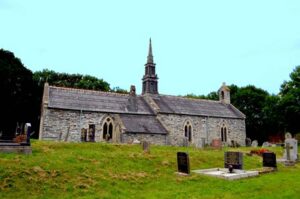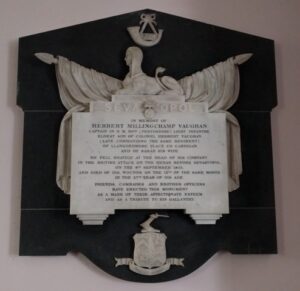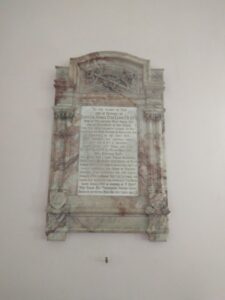Llangoedmore is a village situated two miles east of Cardigan, and is also the name of a Community Council which encompasses Llechryd and parts of Penparc. The parish church is dedicated to St Cynllo, who is said to have once lived here. I have recently visited the church to photograph the several memorials inside and discovered several fine memorials, including a memorial to a local officer who fell during the Boer War and a memorial to three parishioners who fell during the First World War. These men are commemorated below and I have also taken the opportunity to add the details of several other men of the village who are not commemorated.

Crimean War, 1854-1856

Captain Herbert Millingchamp Vaughan, 90th Perthshire Light Infantry. Herbert was the son of Colonel Herbert Vaughan, of Plas Llangoedmor. He served with the 90th Regiment of Foot (Perthshire Light Infantry). The regiment embarked from England for the Crimea in 1854. Herbert was sent out as part of a draft of four officers in June 1855. He was badly wounded during the regiments attack on the Redan on 8 September 1855 and was taken inside for treatment by the Russians. Two days later the Russians evacuated the Redan and left the sick and wounded in the hospital. Herbert was found by a patrol from his regiment, but was in a bad state. A fellow officer wrote:
“He was found at 8 a.m., on the 10th of September, sitting on the lower step of a staircase that led to the upper floor of the building. His leg was badly broken; he had nothing on him but a flannel shirt and a pair of socks, and when first spoken to he was delirious ; he appeared to be very cold, as he was shivering. I procured him water, and it was distressing to see the avidity with which he swallowed it. I procured a stretcher and placed a feather bed on it, and I never left him until I deposited him safely in the lines of the 90th, under the care of Dr. Anderson, the excellent surgeon of that regiment; the first stretcher did not do, and I had it changed at the Redan. His mind wandered frequently, and he then almost always spoke in French,: but by speaking gently to him and by holding his hand , I was generally enabled to make him understand what he was talking about, and then he gave me a clear account of what had occurred to him. He was wounded very soon after entering the Redan. After the attack was repulsed, the Russian officers gave orders that he should be taken carefully to the rear, and while in their presence he was well treated, but I fear he was treated with much brutality as he was being conveyed to the rear. He complained that the men who were taking him dragged him along roughly, and that his broken limb frequently came into contact with gabions, stones, etc, giving him great pain. Upon arriving at the building where I found him, which was full of dead and dying, he appears to have been unkindly treated. His wound had not been dressed. He repeatedly supplicated for water, but no-one gave him a drop. Thank God! they were not Englishmen. It is impossible to conceal that the gallant gentleman’s sufferings must have been intense, but he had a gallant heart to meet his fate, and endure the pain that God thought fit to inflict upon him.”
He died in camp near Sebastopol of his wounds on 12 September aged 27 and was later mentioned in General Simpson’s despatches for his gallantry.
Boer War, 1899-1902

George Evan Lloyd, DSO, Lieutenant Colonel, Duke of Wellington’s (West Riding) Regiment. George was born in 1855, the son of Reverend Rhys Thomas Lloyd and Anna Lewis Lloyd, of Troedyraur Rectory, Penboyr. His uncle was Baronet Lloyd, of Bronwydd. He was educated at Tonbridge School and joined the 70th Foot from the Royal East Middlesex Militia in 1876. He had served with the 51st Light Infantry in the Jowaki Expedition, 1877, and then in the Afghan War, 1878-79, and was present at the attack and capture of Ali Musjid. He was in the Nile Expedition, 1884-85 as commandant at Tangur, and was mentioned in despatches on 25 August 1885. He then served with the Sudan Frontier Field Force, 1885-87, and was again mentioned in despatches and awarded the DSO. He was present at the action at Sarras, again being mentioned in despatches, and then took part in the operations near Suakin in December 1888, where he was again mentioned in despatches. He commanded a field column under Lord Kitchener with the Dongola Expeditionary Force, a command which led to his promotion to Lieutenant Colonel and him being given command of the 1st Battalion, West Riding Regiment. He proceeded to South Africa with his battalion in December 1899, and commanded it throughout the war, including the relief of Kimberley, battle of Paardeberg, and the advance on Bloemfontein and into the Transvaal. He was killed in action at Rhenosterkop on 29 November 1900, aged 45, and is buried in Diamond Hill Military Cemetery. The Boer General Ben Viljoen later wrote of his death: ‘A brave officer who had one of his legs smashed, leant on a gun or his sword, and kept on giving his orders and cheering the soldiers and telling them to charge on. While in this position a second bullet struck him, and he fell mortally wounded.’
World War One, 1914-1918

James Archbold, Private, 16668, South Lancashire Regiment. James was the son of George and Jane Archbold, of Jarrow, and the brother of Barbara Archbold, of Willow House, Haydon Bridge, Northumberland. He had lived at Llangoedmor for at least three years prior to the war, where he worked as a horse driver. He enlisted at Carmarthen on 15 August 1914 into the Welsh Regiment, and in January 1915 was transferred to the 6th Battalion, South Lancashire Regiment. The battalion was attached to 38 Brigade, 13th (Western) Division, and on 13 June 1915 sailed for Alexandria, before being landed at Cape Helles, Gallipoli from 6 July 1915, relieving the 29th Division. The division spent time at ANZAC and Suvla Bay before being evacuated to Egypt during January 1916. On 12 February 1916 the Division began to move to Mesopotamia, to join the force being assembled for the relief of the besieged garrison at Kut al Amara, and then took part in the attempts to relieve Kut. James was killed in action during the Battles of the Hanna and Fallahiyeh on 5 April 1916, aged 29. He is commemorated on the Basra Memorial, Iraq. James is not commemorated in the church.
Richard William Picton Evans, MID, Major, Welsh Regiment. Richard was born at Cardigan in 1873, the son of William Picton Evans and Margarette Ellen Evans. His parents later resided at 13, Queen’s Road, Ealing, London. Richard was educated at Cheltenham College, and married Katherine Frances Blake in London in 1901, the couple moving to Argoes, Cardigan, where Richard ran his own Solicitor’s business. Katherine sadly died in 1909. Richard had served during the Boer War with the 1st Volunteer Battalion, Welsh Regiment, and by the outbreak of the Great War held the rank of Major, with the 4th Battalion, Welsh Regiment. He was posted at his own request to Alexandria in December 1916, joining the front line unit, the 1/4th Battalion, Welsh Regiment, which was attached to 158 Brigade, 53rd (Welsh) Division. Richard played a major part in the battalions subsequent war, seeing action during the three Battles of Gaza, and the triumphant capture of Jerusalem, being wounded at Gaza. Richard died in Palestine on 13 September 1918. He was 46 years old, and is buried at Gaza War Cemetery, Israel. His brother Lawrence also fell.

Thomas Evans, Gunner, 137886, Royal Field Artillery. Thomas was born in Tyrhos, Llangoedmor, the son of John and Mary Evans. His parents later lived at Cnwc, Blaenporth. He enlisted at Preston, Lancashire into the Royal Field Artillery, and at some time during 1916 was posted to B Battery, 76th Brigade, which was attached to the Guards Division. Thomas probably saw action with the division during the Battle of the Somme during the summer of 1916, and the following year the division followed the German withdrawal to the Hindenburg Line. Thomas was one of a number of men of his gun battery who were killed together on 23 April 1917, probably due to German artillery fire. He was 28 years old, and is buried in Canadian Cemetery No. 2, Neuville St. Vaast, France. Thomas is not commemorated in the church.

Ellis James, Private, 50602, King’s Liverpool Regiment. Ellis was born in Llangoedmor in 1880, the son of James and Jane James. He had lived with his wife Laura James, at 3, King’s Avenue, Maltby, Rotherham prior to the war, and enlisted at Cardigan into the Army Service Corps. He was then transferred into the 19th Battalion, King’s Liverpool Regiment, which was attached to 89 Brigade, 30th Division. Ellis would have probably landed in France during 1916 to join the battalion, which had been taking part in the Battle of the Somme. During the spring of 1917 the division followed the German withdrawal to the Hindenburg Line, before taking part in the Battle of Arras, and fought at the Third Battle of Ypres later that year. The division then moved south and got caught up in the German offensive of 21 March 1918, fighting a gallant rearguard action towards the Somme crossings. Ellis was killed in action here on 22 March 1918, aged 38. He has no known grave, and is commemorated on the Pozières Memorial, France. Ellis is not commemorated in the church.

Samuel James, Private, 267081, Welsh Regiment. Samuel was the son of Daniel and Sarah James, of Llangoedmor. He married husband of Margaret Ann Thomas in 1907, and the couple lived at 11, Edward Street, Cwmgwrach, Neath. Samuel enlisted at Carmarthen into the 4th Battalion, Welsh Regiment, and fought at Gallipoli with the battalion. He was later transferred to France, joining the 6th Battalion, Welsh Regiment, which was the pioneer battalion to the 1st Division. The division fought throughout the Battle of the Somme, before moving to Flanders to prepare for a possible offensive on the Flanders coast. Samuel was wounded there, and died of his wounds on 2 July 1917, aged 36. He is buried in Coxyde Military Cemetery, Belgium. Samuel is not commemorated in the church.

Alban David Jones, Private, 25398, Welsh Regiment. Alban was born in Llangoedmor in 1886. By 1891 he was a pauper, living at Cardigan Union, and by 1911 was living with his wife Emma Louisa Jones at 17, New Park Terrace, Treforest. He enlisted at Pontypridd into the 17th Battalion, Welsh Regiment (1st Glamorgan), which was attached to 119 Brigade, 40th (Bantam) Division. The Division moved to France during the first week of June 1916, and moved to the front near Loos. Late in 1916 it moved south to the Somme, and fought at the Battle of the Ancre, remaining in the area over the winter. In March 1917 the Germans withdrew to the Hindenburg Line, and the 40th Division was one of the Divisions that followed the withdrawal. Alban was killed in action during an attack made by the 17th Welsh from Fifteen Ravine on 24 April 1917. He was 30 years old and is buried in Fins New British Cemetery, Sorel-Le-Grand, France. His widow later remarried, and lived at 9, De Barri Street, Rhydfelin, Pontypridd. Alban is not commemorated in the church.

Tom Kane, Private, 37771, Welsh Regiment. Tom was born at Llangoedmor in 1881, and resided at Penffin, Blaenporth prior to the war, with his wife Ann. He enlisted at Cardiff into the 8th Battalion, Welsh Regiment, which was attached to 40 Brigade, 13th (Western) Division. In January 1915 the battalion became the Pioneer Battalion to the Division, and on 15 June 1915 sailed from Avonmouth for Mudros, preparatory to landing at Anzac, Gallipoli on 5 August 1915. Ton joined the battalion at Gallipoli on 10 October, and was on the Peninsula during the terrible winter of 1915. On 8 January 1916, the Division was evacuated from Helles, and by 31 January was concentrated at Port Said, where they held forward posts in the Suez Canal defences. On 12 February 1916 the Division began to move to Mesopotamia, and took part in a hard campaign against the Turks. Tom was wounded during the drive into Mesopotamia, and died there on 9 March 1917, aged 35. He has no known grave, and is commemorated on the Basra Memorial, Iraq. Tom is not commemorated in the church.

John Henry Lloyd, Fourth Engineer Officer, Mercantile Marine. John was the son of Denis and Anne Lloyd (nee James), of Ffos y Teilwr, Llangoedmor. He served with the Mercantile Marine, as an engineer aboard the S.S. Azul, a London registered cargo ship. On 5 February 1917 Azul was en route from Buenos Aires for Cherbourg when she was torpedoed and sunk by the German submarine U-54, with the loss of eleven lives. John was 22 years old when he died that day, and is commemorated on the Tower Hill Memorial, London. John is not commemorated in the church.
James Rees, Private, 29535, South Wales Borderers. James was born at Llangoedmor in 1888, the son of John and Maria Rees. The family later resided at Brynywawr, Penpark. He enlisted at Brecon into the South Wales Borderers, and was posted to France during 1916, joining the 2nd Battalion, South Wales Borderers, which was attached to 87 Brigade, 29th Division. The battalion had been decimated during its attack on Y-Ravine on 1 July, and had been forced to rebuild its strength before taking part in later fighting on the Somme that year. It followed up the German withdrawal to the Hindenburg Line in 1917, before the division fought at the Battle of Arras and the Third Battle of Ypres. James had been taken prisoner by the Germans at some time, and died in captivity on 11 December 1917, aged 29. He is buried in Quievy Communal Cemetery Extension, France. John is not commemorated in the church.
John Thomas, Private, 40680, York and Lancaster Regiment. John was the son of James and Mary Thomas, of Pennar Lodge, Aberporth. He worked as a Farm Labourer at Court Farm, Llangoedmor prior to the war, and enlisted at Cardigan on 5 June 1916, and was mobilised on 19 October 1916 into the Royal Field Artillery, with the service number 162088. On 26 November 1916 John was posted to France on 7 January 1917, joining the 10th Battalion, York and Lancaster Regiment, which was attached to 63 Brigade, 37th Division. The division was at Loos, and at the end of February 1917 moved to the Arras sector, taking part in the Battle of Arras, where John saw his first major action, during the capture of Monchy-le-Preux. The 37th Division then took part in two assaults on Greenland Hill, near the village of Gavrelle. John was killed in action here on 28 April 1917. He was 26 years old, and is buried in Chili Trench Cemetery, Gavrelle, France.


Edward Wilmot Vaughan, Second Lieutenant, Royal Field Artillery. Edward was the son of John Percival Vaughan, and Mabel Florence Vaughan, of Plas Llangoedmor. His father had worked for the Indian Civil Service, and died there in 1906. Edward was educated at Oundle School in England, and at the Royal Military College in Canada before being commissioned into the Royal Field Artillery at Woolwich in May 1915. He was posted to join the 12th Brigade, Royal Field Artillery in France, which was attached to the 4th Division. Edward was killed in action by German artillery fire on 15 July 1916, aged 19. He is buried in Quarry Cemetery, Montauban, France. His cousin, Charles Davies Vaughan, was killed at Gallipoli in 1915.

